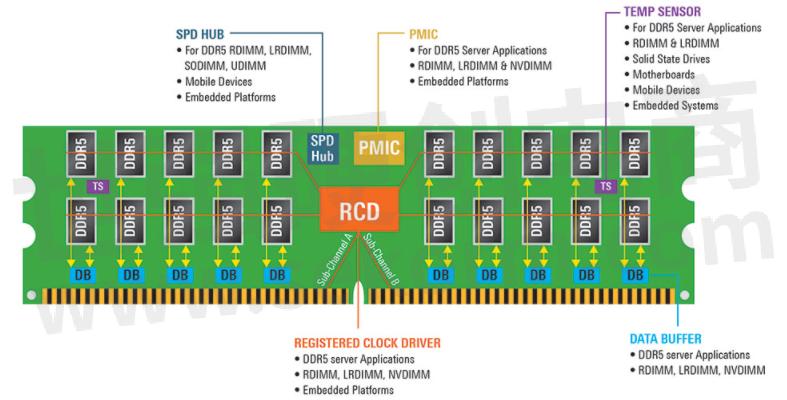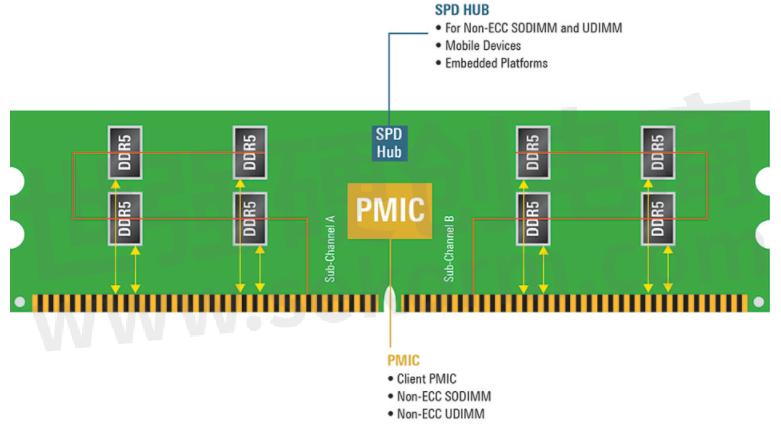What is Driving DDR5? & What does Renesas offer for DDR5?

The market has continued to demand higher capacities, speeds and performance from CPUs as applications continue to need increased bandwidth, capacity and performance-driven by many factors such as artificial intelligence, machine learning and Big Data Analytics. To get data to the CPU as soon as possible, DDR5 DRAM is designed to provide data with lower latency access. The CPU also keeps getting faster, so there is a need for higher bandwidth to move data quickly to the cores that need it, and DDR5 opens the door to bandwidths up to 6400Mbps. DRAM capacity is also critical to computing systems to ensure the data needed can be stored there. The larger the memory capacity, the more likely the operating system will be able to keep the next needed data in memory instead of moving it to slower storage. Over the past decades, shrinking fab processes have led to consistent growth in DRAM die density. With today’s modern production facilities, DDR4 is currently able to achieve up to 16Gb per die and DDR5 will be able to achieve higher densities, as well as enjoy stacking capabilities, such as 3D Stack Through Silicon Via, to accommodate higher capacity modules.
DDR5 introduces new features that will allow next-generation systems to progress and meet customer needs. DDR5 will enable higher performance (higher signaling rates up to 6400Mbps and improved memory channel utilization) and scaling. On die, Error Correction Code (ECC) allows for next process shrinks without driving higher costs, core timing changes to improve design scaling, and higher die density enabling higher capacity at lower power.
What is new in DDR5?
1.2X Channel speed improvement
·Memory bandwidth in DDR5 will reach 6400 MT/s channel speed with an initial speed of 4800 MT/s. DDR4 maximum speed is 3200 MT/s. These higher speeds will lead to higher performance which the industry is waiting for.
2.Higher DIMM Density
·DRAM density - A single DRAM die package can have up to 16Gb, allowing a maximum of 128Gb on an 8-High Stack die package.
·Higher capacity DRAM allows for higher capacity DIMMs. DDR5 can currently have DIMMs up to 512GB on a single DIMM using an 8-High Stack, 16Gb-based DRAM component in an 8Rx4 configuration.
3.Lower Power
·With the reduction of operating voltage - VDD/VDDQ/VPP to 1.1V in DDR5 from 1.2V for DDR4, the power consumption in DDR5 is lower. This helps reduce server and PC power consumption, which is becoming essential in order to reduce datacenter and office building carbon footprints.
4.More efficient power and temperature management
·A voltage regulator on DIMM allows for more efficient power management at the DIMM level.
·A temperature Sensor on DIMM provides spurious thermal monitoring and control.
5.2X 40-bit subchannel on a DIMM
6.Burst length of 16
7.Dual Data Rate (DDR) on command and address interface, as opposed to Single Data Rate (SDR) on command and address interface with DDR4
Server DIMM Architecture and Products
In DDR5, the voltage has been reduced to 1.1V, the frequency range has been significantly increased, and the DQ bus width increased from 72 bits to 80 bits. There is one additional data buffer on the DDR5 LRDIMM compared to DDR4 LRDIMM and DFE support has been added to both the RCD and DRAM. One additional temperature sensor has been added, and there will be a voltage regulator on DIMM (PMIC), which did not exist in DDR4. Finally, there will be I3C sideband bus protocol support. See Figure 1 for details.

Figure 1. Server DIMM
Client DIMM Architecture and Products
DDR5 Client (Figure 2) and Gaming DIMMs (Figure 3) will require Client PMIC and SPD Hub. These were not required in DDR4.
UDIMM

Figure 2. Client UDIMM
SODIMM

Figure 3. Client SODIMM
What does Renesas offer for DDR5?
As with previous generations of DDR memory interface products, Renesas' devices are leading the market in performance and reliability. Renesas has a complete family of ICs to develop high-performance DDR5 DIMMs including - RDIMMs, LRDIMM, NVDIMM, UDIMMs, SODIMMs, gaming DIMMs, and memory interface products for server and client memory down applications.
Renesas’ portfolio includes:
Registered Clock Driver (RCD) 5RCD0148
Power Management IC (PMICs) for RDIMMS and LRDIMMs P8900
Power Management IC (PMICs) for Client Memory Modules P8911
SPD Hub SPD5118
Temperature Sensors TS5111
Data Buffers 5DB0148
I3C Re-driver and I3C Expander Products
Renesas' family of DDR5 and I3C expander ICs enables the next generation of server and client DIMM as well as server and client motherboard solutions to efficiently scale to superior performance, density and reliability while reducing overall system power. With a deep history of delivering industry-leading memory interface chipsets for all DDR generations, Renesas' devices will provide reliable performance to meet the most demanding enterprise and data center applications. Renesas is the only one-stop-shop for all DDR5 DIMM interface products.
- +1 Like
- Add to Favorites
Recommend
- ATP Wide-Temp DDR4 RDIMMs with I-Temp Registered Clock Driver Ensure Maximum Reliability in Extreme Temperatures
- Renesas Introduces Industry‘s First Industrial Temperature Grade DDR5 and DDR4 Registered Clock Drivers
- A Registering Clock Driver Used on DDR5 RDIMMs and LRDIMMs——Renesas RCD 5RCD0148HC2
- Closing the Performance Gap Between DRAM and AI Processors
- Greenconn Obtains Prestigious D&B D-U-N-S® Registered™, Solidifying Its Global Presence
- Renesas Introduces Industry’s First Client Clock Driver and Gen 3 RCD to Enable Demanding DDR5 Client and Server DIMMs
- Benefits of a Point-of-Use Clock for Jitter Optimization Back to top
- OLE WOLFF Drivers Smaller Than 5mm are Ideal for Applications Where Space is Limited and Precision is Required
This document is provided by Sekorm Platform for VIP exclusive service. The copyright is owned by Sekorm. Without authorization, any medias, websites or individual are not allowed to reprint. When authorizing the reprint, the link of www.sekorm.com must be indicated.






























































































































































































































































































































































































































































































































































































































































































































































































































































































